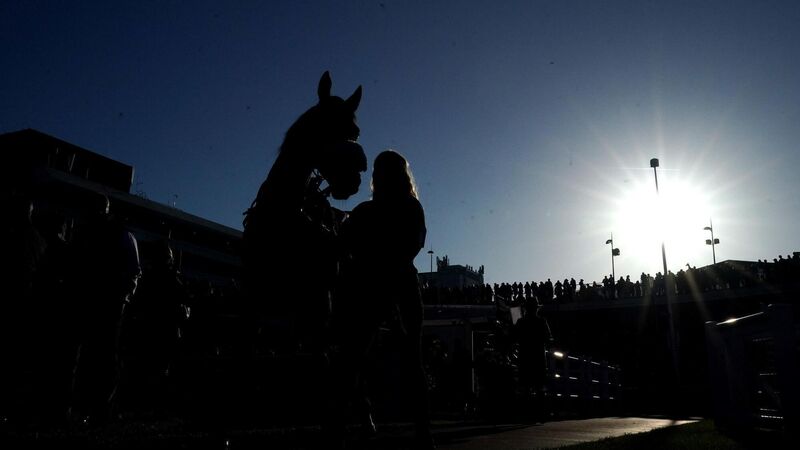Ruby Walsh: No easy answers to the pesky winter sun debate

BLINDING: Low-lying sun caused consternation at Cheltenham last weekend, forcing the removal of a host of obstacles. Picture: Tim Goode/PA
Cheltenham in November always seems to spark the debate of whether jumps should have been omitted or not, and I am not sure if there is a correct answer.
I was involved in numerous conversations throughout my career where hurdles or fences were omitted or left in because of the low-lying sun and the shadow it projected.
The pot should never call the kettle black, so I am not going to, but after a week where the focus seems to be on the jumps that weren't jumped instead of the ones that were, I am going to join the debate.
I get, and fully understand, that a horse's eyes are set at a different angle to ours, and their vision is different too. That's not a debatable fact, but a horse race requires a horse and rider, so human eyes and vision come into the equation too.
The glaring winter sun causes plenty of confusion on our roads, and it’s no different on racecourses, but that's only one point of the debate. I have little doubt I got many falls because of my or a horse's indecision, not primarily because of the sun, but one sure way of being indecisive is when you struggle to see.
The debate is: What are you looking for? And when does it become hard to see? The answer for me had always been the orange — now white in the UK — take-off board. That guide, never the top of the jump, is where every take-off point is gauged or measured.
It's the one thing you have to be able to make out clearly, and I don't care if the horse can always see it because, if the jockey can't then you have an issue. So, when can you not see it? Usually, when on an incline of any degree, racing directly into a low sun, throwing a relatively short shadow so everything appears black.
For example, I never believed Annie Power tried to jump a shadow that infamous afternoon at Cheltenham because the orange take board was obvious, and the sun was high enough to cast a long shadow. Likewise, I believe Secant Star took off at the shadow line and fell at Leopardstown with me many years ago. Can I prove it? No, but I firmly believe it.
Many small changes have been made over the years to limit the number of jumps omitted, such as having the chases first at Thurles so the fences across the top can always be jumped. If there is no cloud cover in the late afternoon when the sun comes around, then only one hurdle must be missed instead of two fences.
But is that it? Cloud cover? Do we have fewer clouds than we did? Do we have more sunshine? I know we have more wind and grass growth in November, and for the grass to grow, you need heat from the sun. I am not an expert in weather or the climate, but something has changed, and I don't have a simple answer.
I believe that once you can see the take-off board clearly, a jump is safe to be approached, but when it's all black, it's unfair to expect anyone to take it on, even if people can prove the horse knows what it's doing.
Haydock doesn't usually have sun issues, nor does Ascot, and both stage cracking races on Saturday afternoon. On the northeast coast in Lancashire, A Plus Tard will bid to retain his Betfair Chase crown, and even the rainfall will struggle to derail Henry de Bromhead’s charge.
It is a small select field, but if I trained a horse I believed to be a possible Gold Cup runner I, too, would be avoiding APT this early in the season. Pick your battles and all that!
Venetia Williams has done that with L'Homme Presse, who goes to Ascot for the Amlin Chase. That is the undercard because Constitution Hill will be the star attraction in Berkshire. The runaway winner of the Supreme Novices’ Hurdle is the new kid on the Champion Hurdle block, and I hope he blows away his four rivals here, creating more hype, debate, and anticipation for the season ahead.
On home soil, Punchestown stages its two-day winter weekend, culminating with Sunday's Morgiana Hurdle. Willie Mullins only declared three of his six entries, with old reliables Sharjah and Saldier joined by State Man.
If State Man is to push himself into the picture that contains Honeysuckle and Constitution Hill, he will have to win this Grade One contest. Bar falling two from home on debut at Leopardstown last Christmas, he has done very little wrong. His win here last April was very impressive, and I hope he throws his hat in the ring.
The weekend is not short of star names, and many of them will be hard to oppose, but Alan King has definitely chosen the brave route for Edwardstone. Pitching him into an Ascot handicap carrying 12 stone against some race-fit rivals, all of which receive lumps of weight from his star novice of last season, is no easy task. If he can deliver, the UK will have a backup to Shishkin in the two-mile chase division.









